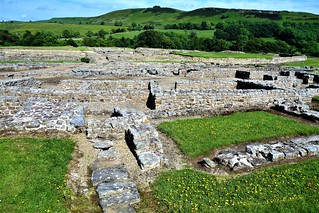Vindolanda, Roman Britain
Introduction
This afternoon, I am reporting on Vindolanda, one of the most important archaeological sites in Britain.
Landscape view of Vindolanda
Location
Near Bardon Mill, Northumberland.Twenty eight miles east of Carlisle and thirty four miles west of Newcastle-upon-Tyne.
Roman Bathhouse
Importance of the Site
Together with sister sites at Carlisle, Carvoran and Corbridge Vindolanda formed part of an early 'open' northern frontier in northern Britain.These sites were aligned on early, east-west, Roman road called Stanegate.Vindolanda was constructed around AD85 and for around forty years thereafter (until construction of Hadrian's Wall) was a key, front line fort in a hostile environment. Upon completion of Hadrian's Wall, just to the north of the Stanegate, Vindolanda remained an integral part of the northern defences whilst not physically forming part of the famous wall.
Vindolanda has many similarities with other forts on Hadrian's Wall, i.e.a well constructed military fortification based on a 'playing card' design close to which was a 'vicus' or civilian settlement which grew up to serve the needs of the military personnel.In the early years there was a succession of six forts on the site, mostly made of wood which needed regular renewal. This aspect is key to today's archaeology as each new fort was built on top of it's predecessor. Thus the layer upon layer has kept the air away creating an anaerobic environment which is conducive to preservation of organic materials such as wooden items and leather products including shoes.
Layers of archaeology
Vindolanda Writing Tablets
These 'tablets' underpin the importance of Vindolanda through today's eyes.They consist of postcard size, thin pieces of wood covered in an inked Latin script.First discovered in 1973 they date from around AD105 and form one of the earliest and most important historical archives from the Roman Empire and Britain.
The tablets include every day communications between soldiers, slaves, women and children from all stratas of society at the site.Their preservation is attributed to a sudden rain storm extinguishing the fire on which the tablets were placed for destruction and then subsequently forming part of the anaerobic conditions explained above.Starting in 1973, almost 2000 of the tablets have been discovered plus another 400 or more, wax on wood, stylus tablets.
Example of Vindolanda Tablet
The life of Vindolanda
Between AD 85 and AD 410 Vindolanda was part of the Roman Empire but after the Roman withdrawal from Britain it seems the garrison was abandoned to it's own devices, probably merging with the local population and existing by farming and using the trading routes established by the Romans. It seems life continued at the site through to final abandonment around AD900 when Vindolanda fell within the Saxon kingdom of Northumbria,
Visiting the site
Superficially, there are many physical similarities with sister sites such as Housesteads and Chesters but visitors would be rewarded by (a) undertaking preliminary research then (b) joining one of the free guided tours on offer and finally (c) allocating about one hour to the excellent site museum where a vast array of site finds and interpretation material can be seen.
Fort remains in context of local landscape
Below is a video clip of the site.






Comments
Post a Comment